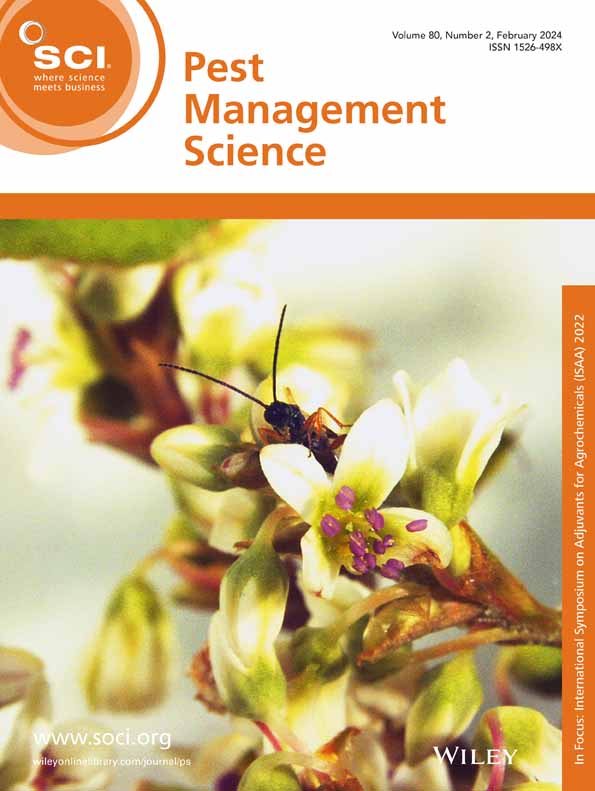Loop-mediated isothermal amplification combined with alkaline lysis to detect Colletotrichum fructicola infection on oil-tea plants.
IF 3.8
1区 农林科学
Q1 AGRONOMY
引用次数: 0
Abstract
BACKGROUND Camellia oleifera anthracnose (COA), caused by Colletotrichum fructicola, is a serious threat to both the yield and quality of Camellia oleifera oil (COO). To detect and distinguish incipient C. fructicola infection on asymptomatic plants is essential for COA control. Therefore, an efficient and rapid diagnostic method for detection of C. fructicola is desperately needed for making management strategies promptly. RESULTS We created a loop-mediated isothermal amplification (LAMP) method in conjunction with alkaline lysis (AL) to differentiate C. fructicola from other COA-related Colletotrichum species. Compared to the conventional polymerase chain reaction (PCR) method, the LAMP method not only exhibited higher sensitivity and specificity in the detection of C. fructicola but also required less complicated equipment (just a dry bath), less operating time (30 min for plant crude DNA lysis and 15 min for LAMP assay), and could be used for on-site diagnosis. The minimum detectable concentration of the C. fructicola DNA using LAMP was 10 pg, which was 100 times lower than the conventional PCR. Furthermore, the AL method of extracting crude genomic DNAs (gDNAs) from oil tea leaves could be applied for the LAMP detection under field conditions with a sensitivity of up to 5 × 103 spores mL-1 of C. fructicola infection, which was ten times more sensitive than conventional PCR. CONCLUSION We developed a LAMP assay combined with an AL DNA extraction method (LAMP-AL) to accurately detect and differentiate the C. fructicola infection on oil-tea leaves. The assays specifically detailed here are portable and simple to apply in the field conditions with limited resources. © 2025 Society of Chemical Industry.环介导等温扩增联合碱性裂解检测油茶炭疽菌侵染。
油茶炭疽病(COA)是油茶炭疽菌(Colletotrichum fructicola)引起的一种严重威胁油茶油(COO)产量和质量的病害。在无症状植物上检测和鉴别早期果蛾侵染对COA防治具有重要意义。因此,迫切需要一种高效、快速的检测方法,以便及时制定防治策略。结果建立了环介导等温扩增(LAMP)与碱性裂解(AL)相结合的方法,可将果孢菌与其他coa相关的炭疽菌进行区分。与传统的聚合酶链反应(PCR)方法相比,LAMP方法不仅在检测果霉方面具有更高的灵敏度和特异性,而且设备简单(只需干浴),操作时间短(植物DNA裂解30 min, LAMP测定15 min),可用于现场诊断。结果表明,LAMP的最低检测浓度为10 pg,比传统PCR低100倍。此外,油茶叶片粗基因组dna提取方法可用于田间LAMP检测,灵敏度可达5 × 103孢子mL-1,灵敏度是常规PCR的10倍。结论建立了一种结合AL DNA提取法(LAMP-AL)的LAMP检测方法,可准确检测和鉴别油茶叶片上的果菌感染。这里特别详细介绍的测定方法便于携带,易于在资源有限的现场条件下应用。©2025化学工业协会。
本文章由计算机程序翻译,如有差异,请以英文原文为准。
求助全文
约1分钟内获得全文
求助全文
来源期刊

Pest Management Science
农林科学-昆虫学
CiteScore
7.90
自引率
9.80%
发文量
553
审稿时长
4.8 months
期刊介绍:
Pest Management Science is the international journal of research and development in crop protection and pest control. Since its launch in 1970, the journal has become the premier forum for papers on the discovery, application, and impact on the environment of products and strategies designed for pest management.
Published for SCI by John Wiley & Sons Ltd.
 求助内容:
求助内容: 应助结果提醒方式:
应助结果提醒方式:


